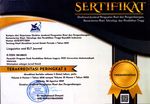Exploring the Nature of Interactions in Science Classroom
Abstract
Full Text:
PDFReferences
Bruna, R. & Gomez, K. (2009). The Work of Language in Multicultural Classrooms: Talking Science, Writing Science. New York & London: Routledge
Boyd, P. & Markarian, W. (2011). Dialogic teaching: talk in service of dialogic stance. Language and Education, 25(6), 515-534.
Brown, B. A., & Spang, E. (2008). Double talk: Synthesizing everyday and science language in the classroom. Science Education, 92, 708–732. doi 10.1002/sce.20251
Candela, A. (1998). Students’ power in classroom discourse. Linguistics and Education, 10(2), 139-163.
Cazden, C. B. (2001). Classroom discourse: The language of teaching and learning. Portsmouth, NH: Heinemann.
Evnistkaya, N., & Morton, T. (2011) Knowledge Construction, Meaning Making and interaction in CLIL Science Classroom Communities of Practice. Language and Education, 25(2) 109-127.
Gardner, S. (2008). Transforming talk and phonics practice: Or, how do crabs clap? TESOL Quarterly, 42(2), 261-284.
Gibbons, P. (2003). Mediating language learning: Teacher interactions with ESL students
in a content-based classroom. TESOL Quarterly, 37(2), 247-273.
Idris, S. (2016). The impact of globalization, language policy, and language learning on identity construction: An ethnographic case study of a high school community in Bima, Indonesia. The University of Texas at San Antonio: ProQuest Dissertations Publishing.
Leander, K. (2002). Silencing in classroom interaction: producing and relating social spaces. Discourse Processes, 34(2), 193-235.
Lee, Y. (2008). Yes–no questions in the third-turn position: Pedagogical discourse processes. Discourse Processes, 45, 237-262.
Lidar, M., Lundqvist, E., & Östman, L. (2006). The interplay between teachers’ epistemological moves and students’ practical epistemology. Science Education, 90, 148–163. doi 10.1002/sce.20092.
Liu, Y, & Hong, H. (2009) Regulative Discourse in Singapore primary English classrooms: teachers choices of directives. Language and Education, 23(1), 1-13.
Mackey, A., Kanganas, A.P., & Oliver, R. (2007). Task familiarity and interactional
feedback in child ESL classrooms. TESOL Quarterly, 41(2), 285-312.
Matsumoto, Y. (2010). The impact of group dynamics on the L2 speech of student nurses in the classroom. Procedia - Social and Behavioral Sciences, 3, 180-189. doi.org/10.1016/j. sbspro.2010.07.030
Mortensen, K. (2009). Establishing recipiency in pre-beginning position in the second language classroom. Discourse Processes, 46, 491-515.
Nystrand, M., Wu, L., Gamoran, A., Zeiser, S., & Long, D. (2003). Questions in time: investigating the structure and dynamics of unfolding classroom discourse. Discourse Processes, 35(2), 135-198.
Scott, P. H., Mortimer, E. F., & Aguiar, O. G. (2006). The tension between authoritative and dialogic discourse: A fundamental characteristic of meaning making interactions in high school science lessons. Science Education, 90, 605-631. doi: 10.1002/sce.20131
Temmerman, M. (2009). Communicative aspects of definitions in classroom interaction: learning to define in class for the first and second language learners. Linguistics and Education, 20(2), 126-144.
Thompson, P. (2008) Learning through extended talk. Language and Education, 22(3), 241-256.
Van Dam, J. & Bannink, A. (2006). A dynamic discourse approach to classroom research. Linguistics and Education, 17(3), 283-301.
Walton, M. (2000). Say it's a lie or I'll punch you: naive epistemology in classroom conflict episodes. Discourse Processes, 29(2), 113-136.
DOI: https://doi.org/10.31764/leltj.v7i2.1740
Refbacks
- There are currently no refbacks.
Copyright (c) 2020 Linguistics and English Language Teaching Journal

This work is licensed under a Creative Commons Attribution-ShareAlike 4.0 International License.
_____________________________________________________
Linguistics and ELT Journal
p-ISSN 2339-2940 | e-ISSN 2614-8633

LELTJ is licensed under a Creative Commons Attribution-ShareAlike 4.0 International License.
_____________________________________________________
LELTJ is abstracting & indexing in the following databases:
_____________________________________________________
LELTJ Editorial Office:













